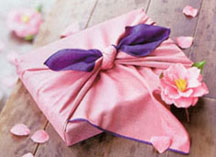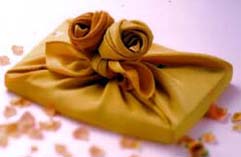 @@@@@@@@@@@@@@@@@@@@@@@@@@@@ @@@@@@@@@@@@@@@@@@@@@@@@@@@@
 @ @
gFuroshikih
is a scarf-like square cloth used for wrapping, carrying and storing things.
The furoshiki is very handy since it is so easily
adaptable to the size and shape of the article being wrapped, and when not in
use it can be folded up and easily carried in the hand or pocket. The usual way
of wrapping an article is to place it in the center of the furoshiki, and tie
first one pair of diagonally opposite corners together over the article,
followed by the other pair.
Origin
and history
The custom of using cloth for wrapping in Japan began as early as the Nara
Era (710-794). The name gfuroshiki,h which combines the words gfuroh meaning
gbathh and a form of the verb gshikuh meaning gto spread,h dates back to
the early part of Edo Era (1603-1868) when public baths became popular.
People carried their belongings in a square cloth to a public bath house
and spread the cloth for use as a bath-mat.
Size, material, color and pattern
Furoshiki come in various sizes and materials.
They range from 45 to 225 centimeters, the most common being about 75
centimeters. Materials used to make furoshiki include silk, wool, cotton,
rayon, and other man-made fibers. There are also a wide variety of patterns and
colors, from plain-colored with a name or family crest to detailed, traditional
patterns, and even modern patterns.
How to wrap
There are three basic ways of wrapping with
furoshiki:
1. Hirazutsumi (just
wrapping),
2. Hitotsumusubi (with one knot)
3. Futatsumusubi (with two knots).
Other methods are all variations. Some practical methods of wrapping furoshiki
are as follows:
1. Otsukaizutsumi is the most popular way of
wrapping square articles.
2. Binzutsumi is a method of wrapping long bottles.
3. Kakushizutsumi, a modification of otsukaizutsumi, is a good way to hide the knot.
4. Makizutsumi is a method for wrapping cylindrical articles such as tea canisters and scrolls.
5. Suikazutsumi is the
method used for wrapping watermelons.
Furoshiki
in current days
Although furoshiki are still used in Japan, their use has declin ed in the post-war period. This is mainly because people adopted Western-style dress. Once handbags and paper shopping bags
arrived on the scene in the 1950s, people found fewer reasons to bring
furoshiki along wherever they went. When plastic bags made their appearance
in the 1970s, the custom and culture of using furoshiki almost faded away. ed in the post-war period. This is mainly because people adopted Western-style dress. Once handbags and paper shopping bags
arrived on the scene in the 1950s, people found fewer reasons to bring
furoshiki along wherever they went. When plastic bags made their appearance
in the 1970s, the custom and culture of using furoshiki almost faded away.
@In recent years, however, the use of furoshiki
has seen a renewed interest as movements to conserve the environment and re-evaluation of Japanese traditional culture have become more prominent. A number of new and innovative uses of furoshiki have been proposed on top of its conventional techniques. The furoshiki is becoming more and more versatile, being used, for example, as a gift wrapper, a table covering or other interior decoration. Light, less bulky furoshiki could also be a suitable souvenir!
|

 ed in the post-war period. This is mainly because
ed in the post-war period. This is mainly because